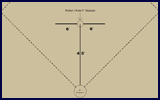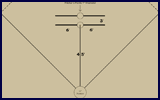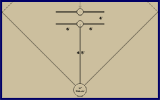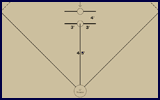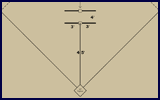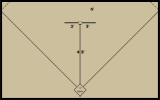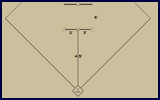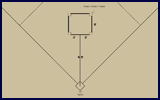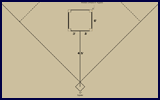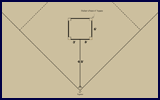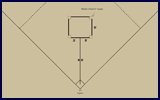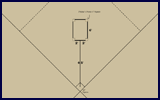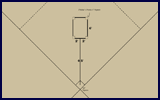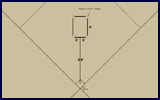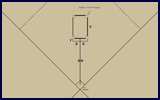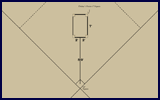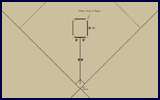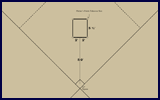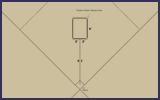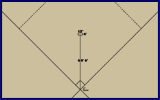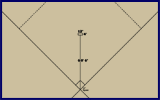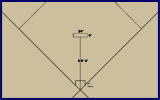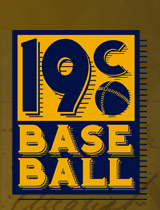The Pitcher's Area
By Eric Miklich
Until the convention of 1857 there were no written stipulations of the distance from the position the pitcher delivered the ball from to home base. The distance between the two is assumed to be 45 feet; however, the ending, nor the staring point of that distance, was discussed. During the Convention of 1857, the length of the pitcher's line was now written as being 4 yards long (third base to first base) with its center placed at 15 yards from home base and centered to an imaginary line drawn from home base to second base. It is agreed that the newly instituted 12 foot pitcher's was used as the starting point in measuring the 45 feet between the pitcher and home base, but what constituted the ending point? Did the 45 feet measured from the pitcher's line to the intersection of the first and third base foul lines, to the middle of home base or to the front of home base? The center of the pitcher's line was marked by a fixed circular iron plate. Pitcher's were allowed to roam free as long as the ball was delivered within and behind the 12 foot line. If a pitcher delivered the ball while stepping over the pitcher's line, the umpire was required to call a baulk, or balk and all base runners advanced one base. The pitched ball was considered dead as soon as a balk was announced.
Beginning in 1858, umpires were allowed to begin calling strikes on a batter that did not swing at fair or good balls delivered by the pitcher. This was done to prevent the batter from refusing to swing. Batters took this approach to allow base runners to steal bases and get into scoring position or even steal home. It was also a technique used to tire the pitcher. Prior to 1860 there have been written accounts where a batter has taken over 30 pitches in one at bat.
Umpires were instructed to warn the batter once, before calling strikes. Each umpire was given the freedom to decide when the batter should be warned and when to begin calling strikes. The rules did not instruct an umpire as to when this should be done. After a warning and three called strikes, the batter was required to run to first. The catcher was required to catch the ball on the fly or the fist bound to retire the batter. If he did not he was forced to throw the ball to the fielder at first base to retire the batter.
In 1860 more elaborate rules were agreed upon and the circular home base rested on the intersection of the third and first base foul lines. The distance from the center of the pitcher's line to the undetermined area at home base was still 45 feet. Placed on the center of the pitcher's line and in line with home base and second base was a "fixed iron plate." This was to be 9 inches in diameter and circular. It was painted or enameled white.
All pitching since 1845 had been underhand pitching but the 1860 rules specifically addressed a violation. The pitcher was not to let his pitching arm touch his side, or be "jerked," in the act of delivery. This prevented a pitcher from winding up and letting his forearm hit his hip and attain a "whipping" action when delivering the ball.
It was agreed upon that for the first time in 1863, that a second line 12 foot line, or rear pitcher's line, would be drawn on the field three feet behind the original pitcher's line. This new line was also required to have a "fixed iron plate" placed on its center, was to be nine inches in diameter, circular and painted or enameled white. With the pitcher required to start and end within the two 12 foot pitching lines it was nearly impossible to step when delivering the ball. The pitcher's running start was eliminated, thus helping to reduce the speed with which the ball was being delivered to the batter. The pitcher was not allowed to have either outside of the pitcher's lines during the delivery. The pitching distance of 45 feet was still measured from the front pitcher's line "to home base." The umpire was allowed to call unfair pitches delivered to the batter, "balls," for the first time, after issuing the pitcher a warning. After a warning and three called balls the batter was allowed to take first base. Any base runner that occupied a base, forced to move or not, also moved to the next base.
There were no changes to the two pitcher's lines but the pitcher was to have both feet on the ground when the ball left the pitcher's hand. If he did not a balk was to be called by the umpire.
In 1867, both the front and rear pitcher's lines were reduced to 6 feet in length and the back line was moved one foot toward second base to increase the distance between them to 4 feet. Each line still had a circular 9 inch flat iron marker placed in the center of them. For the first time the position of the pitcher's arm was discussed and it was specified that the pitching arm was to be straight and only move perpendicularly to the ground.
When home base became square in 1868, the center of home base was placed where the third and first base foul lines intersected. One corner touched each foul line and a flat side faced the pitcher. The pitcher's lines were separated further and the back line was now 6 feet from the front line and each still had a marker, but that was changed to a 6 inch by 6 inch square flat iron plate. The 45 foot pitching distance, its starting point and ending point reminded the same.
In 1869 the rear pitcher's line was moved back another 2 feet and was now 6 feet from the front line.
When the National Association of Professional Base-Ball Players commenced in 1871, the pitching distance remained at 45 feet from the center of the front pitcher's line to the "area" of home base. The two fixed square iron plates centered on each of the Pitcher's lines also remained. Home plate was also specified to be placed so that one corner faced the pitcher, the Pitcher's Point and the opposite corner; the Catcher's Point faced the catcher. Although the diagram from the 1870 Beadle's Dime Base Ball Player from 1870 shows Home Base placed in this manner, it was not specified in the rules. With Home Base in this position, the pitcher now had 17 inches to throw the ball over as opposed to 12 inches the previous season. The first pitched ball delivered to each batter was not to be called by the umpire.
The second NA season, 1872, had only one change to the pitcher's position. There were now three square flat iron plates on the front pitcher's line, 6 inches by 6 inches. One was placed at the ends of the line, one remained in the center. The back line remained 6 feet from the front line.
The pitcher's area became a pitcher's box for the 1874 season. For the first time the rules specifically stated that the pitcher's position was to be marked by a 6 foot by 6 foot box. Each corner of the box was required to have a 6 inch by 6 inch flat iron plate placed in each corner. The pitching distance, still 45 feet, was specified for the first time to be from the front line of the pitcher's box to the center of the home base, which rested on the intersection of the third and first base foul lines.
No changers were made to the pitcher's box for the 1875 season, which was the last season for the NA, but home plate was moved entirely into foul ground and the pitcher's point now rested on the intersection on the first and third base foul line. The corner markers were now allowed to be made of stone or iron.
The National League of Professional Base Ball Clubs began in 1876 and there were no changes made to the pitcher's position, however, from 1876 until 1893 all pitching distances would be measured to the center of Home Base.
In 1877, home base was moved entirely in fair ground but the pitching distance and the dimensions and composition of the pitcher's box remained the same. Home Base would remain entirely in fair ground for the remainder of the 19th century.
The back line of the pitcher's box was moved two feet closer to the front line for the 1879 season making the Pitcher's Box 6 feet by 4 feet. The pitcher was required to face the batter in 1879 and his pitching hand now had to pass below his waist but still be nearly perpendicular to his body.
In 1881 the NL increased the pitching distance from the front of the pitcher's box to the center of home base to 50 feet.
When the American Association of Base Ball Clubs began in 1882, it instituted the same pitcher's box as the NL, which made no changes from the previous year.
The requirement for 1883, in both the National League and American Association, was that the pitcher's hand had to be below his shoulder during the delivery.
The National League lifted all restrictions on the pitcher's delivery for the 1884 season.
The Union Association also used the same pitcher's box dimensions as the National League and American Association for their only season in 1884 and followed the American Association's pitching rules.
The American Association lifted all restrictions on pitching on June 7th of 1885.
In 1886 both the NL and AA lengthened the pitcher's box by one foot. The distance from the front line to the back line was now 7 feet. The AA added a one foot by four foot smooth flat stone that was placed in front of pitcher's box and used to aid the umpire in determining if the pitcher was stepping past the front line when delivering the baseball.
In 1887, the pitching distance and rules were changed again. Both the NL and AA agreed to use the same set of playing rules. The pitcher's box was to be 5½ feet long (home to second) by 4 feet wide. Before delivering the ball, pitchers were required to have one foot on the back line of the pitcher's box at all times, face the batter, hold the ball so the umpire could see it and were allowed only one step in their delivery. The pitching distance was now 55½ feet from the rear line of the pitcher's box to the center of home base. The front line was still 50 feet to the center of home base. Each corner of the Pitcher's Box was still required to have a six inch square iron plate or stone marker.
The Players' National League of Base Ball Clubs played its only season in 1890. The Pitcher's Box was listed as 6 feet long (home to second) by four feet wide. The pitching distance was measured the same way as the NL and AA, from the back line of the pitcher's box to the middle of home base, except the Players' League placed the front line of the pitcher's box at 51 feet from home base making the pitching distance 57 feet. Each corner of the pitcher's box had to be marked by a circular wooden peg, even with the ground.
The NL and AA followed the lead of the Players' League and instituted circular rubber markers for the corners of their Pitcher's Boxes in 1890. The Pitcher's Box remained 5½ feet by 4 feet.
After the 1891 season the NL absorbed four teams of the defunct AA.
Major changes were instituted for the 1893 season. The pitcher's box was removed and replaced with a whitened rubber "Pitcher's Plate," that measured 12 inches (third to first) by 4 inches and was even with the surface. The back of the pitcher's plate was centered on an imaginary line drawn from the intersection of the third and first base foul lines to the center of second base. The new pitching distance, 60 feet 6 inches, was measured from the front of the pitcher's plate to the intersection of the third and first base foul lines.
In 1895 the pitcher's plate was size was increased in length (third to first) from 12 inches to 24 inches and in width from 4 inches to 6 inches.. The pitcher's position did not change for the rest of the 19th century. It is extremely important to note that all pitching in the 19th century was done from a flat surface. The "pitcher's mound" would not make its debut until the 20th century.
